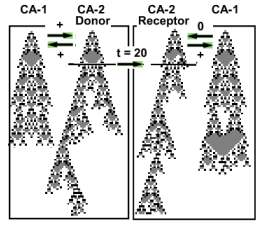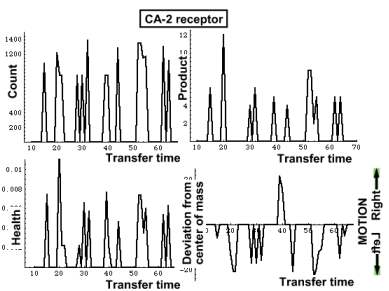 |
Immunity transfer
In the previous experiment immunity was conferred on an non immune host, at t = 40. A similar outcome may be achieved when transferring the immune state at t=20. Two zygote couples were planted At t = 20, CA-2 donated its structure to CA-2 receptor, which then became immune to CA-1. Some time later CA-1 died, which is a token of host immunity. Following transfer, CA-2 receptor structure evolves in a different way than that of the donor CA-2, since their respective impacts differ. Impact of the receptor CA-2 remains I = { 0 , +}.
 |
Immunization context
We notice that the present transfer affected the parasite in a different way than the transfer at t=40 of the previous experiment. The outcome of immunization depends on the context of the host. Which is true also in real life. Some children react to immunization with a fever, while other do not react at all. Their reaction depends on the context of their respective organisms. Context is defined as set of processes operating in the organism during immunization. In the present experiment context is determined by the time of immunity transfer.
We now we explore the immunizing potential of other states and contexts. The graphs below depict CA parameters at different transfer times. Not all transfers ended in a successful outcome. In some, CA-1 did not die, in others, CA-2 died. The graphs depict only successful outcomes, when CA-2 thrived, and CA-1 died. Out of 62 transfers only 16 (=26%) conferred immunity.
 |
CA-2 size (count)
was the largest at t = 31.
At t = 20, CA-2 produced the most and was also the healthiest. The
last graph depicts the deviation of the center of mass form the middle of
the image, which indicates motion . (Compare with a previous
experiment). Most CA moved to the left, while the CA which was immunized
at t = 40 moved to the right. CA immunization confers upon the host more
than just immunity. It changes its structure, and size, may enhance production
and induce motion. By choosing an appropriate transfer time the host may
be endowed with new features. In order to maximize size, we ought to immunize
at t = 31. Immunization at t = 20 maximizes production, and health.
Immunizations at t = 40 and t = 51 drive the CA-2 respectively to the right, and left.
Immunization confers more then just immunity. The CA learns
new strategies, like raising production, or moving. The different states of the donor CA-2 may be regarded as a
library of actions, or a repertory,
which may be transferred to the recipient for
different purposes. The above graphs depict only immunizing outcomes.
Yet non-immunizing outcomes may also be significant. A thriving CA-1 which was regarded above as parasite, might
turn into a symbiont with a favorable effect on CA-2, which grows in size, and produces
more cells.
What is the nature of the information transferred from donor
to recipient? It is more than
a set of signals, and therefore cannot be treated with tools of information
theory, like Entropy. There is no
correlation between the entropy of a state and its immunizing potential.
One might assume that entropy
might be useful in certain CA
subsets. Apparently there are none. Neither in the realm of CA nor in life. Here entropy is simply meaningless and useless. Schroedinger suggested that organism becomes
more complex by feeding not on energy, but on negentropy. But even this metaphor is
of no help. How does CA-2 confer negentropy on the recipient?
In his book "Thermodynamics
of Irreversible Processes" Prigogine pointed out a serious limitation in classical thermodynamics
of being restricted to reversible processes and equilibrium states. Yet
even his solution fails to account for state transition in an evolving CA.
Life does not feed on negentropy it is simply creative,
and this property of life cannot be reduced to the simplistic models of
Physics.
Apparently "The New Kind
of Science" reveals much more than Wolfram anticipates, it opens a
CA-Pandora box which undermines most physical theories, models, or metaphors,
particularly when applied to Life.
Further Reading:
Physics
as Fable
Setup
switchstate [3, 2, j, mm, 1]; effect[1, 30 + 2 sa[[2]]]; effect[2,
15 + sa[[1]]]; effect[3, 15 ];